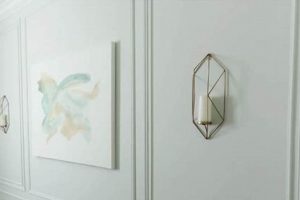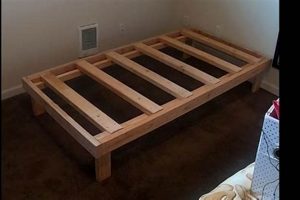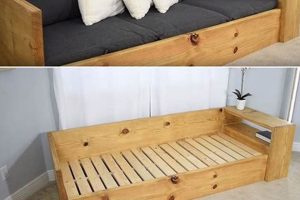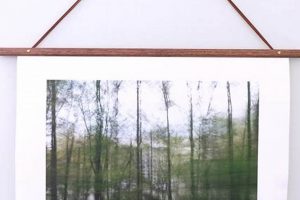A handcrafted decorative object, involving the preservation of botanical specimens within a transparent border, serves as a personalized form of artistic expression. This activity utilizes dried floral components arranged and secured inside a structure designed for display, often employing glass or acrylic sheets to showcase the delicate composition.
The creation of botanical artwork offers numerous advantages, including stress reduction through engagement with natural elements and the cultivation of artistic skills. Furthermore, it provides a tangible connection to the environment and preserves seasonal flora for extended enjoyment. Historically, pressing and displaying plant materials dates back centuries, evolving from scientific documentation to a recognized craft.
The subsequent sections will detail the materials needed, the pressing process, assembly techniques, and design considerations for constructing this personalized botanical display.
Crafting a Lasting Botanical Display
Achieving optimal results in the construction of this handcrafted botanical art requires careful attention to detail and adherence to proven techniques.
Tip 1: Selection of Flora: Choose plant materials free from moisture and imperfections. Avoid overly thick blossoms, as they are more prone to mold during the drying process. Select flowers and foliage that complement each other in color and texture to create visual harmony.
Tip 2: Proper Pressing Technique: Ensure thorough dehydration of plant materials by utilizing appropriate pressing methods. Employ blotting paper or newspaper to wick away moisture, replacing it regularly during the initial pressing stages. Allow sufficient time for complete drying, which may take several weeks depending on the plant’s thickness and the ambient humidity.
Tip 3: Frame Preparation: Select a frame appropriate for the scale and style of the intended arrangement. Clean the glass or acrylic thoroughly to ensure optimal clarity. Consider applying a UV-protective coating to the glass to minimize fading of the preserved flora over time.
Tip 4: Adhesive Selection: Use a pH-neutral adhesive to secure the pressed materials to the backing. Acidic adhesives can damage the delicate plant matter over time. Apply the adhesive sparingly to prevent unsightly residue or discoloration.
Tip 5: Composition and Arrangement: Plan the arrangement carefully before adhering any elements. Consider the principles of design, such as balance, symmetry, and focal points. Experiment with different layouts to achieve a visually pleasing and cohesive composition.
Tip 6: Sealing and Protection: After assembling the botanical art, seal the frame properly to prevent moisture and dust from entering. This will help to prolong the lifespan and preserve the aesthetic quality of the display.
Tip 7: Storage and Display: Avoid direct sunlight when displaying the completed artwork, as this can cause the pressed flowers to fade. Store the piece in a cool, dry environment to prevent moisture damage or insect infestation.
By following these recommendations, one can create a botanical artwork that is both aesthetically pleasing and enduring, preserving natural beauty for years to come.
The concluding section will summarize the key steps involved and offer insights on long-term maintenance and care.
1. Floral Selection
The selection of flora directly influences the aesthetic outcome and longevity of a pressed flower display. The choice of plant material serves as the foundational element, dictating the composition’s color palette, textural complexity, and overall visual impact. For instance, using hydrangeas, with their dense, multi-petaled blooms, may introduce challenges in achieving uniform pressing due to their thickness, potentially leading to uneven drying and increased risk of mold. Conversely, flatter blooms like pansies or violets are generally easier to press and preserve. The practical understanding of how different floral characteristics interact with the pressing process is therefore paramount to the success of the project.
Beyond the aesthetic, floral selection impacts the preservation process. Certain species are naturally more resilient to drying and exhibit greater color retention than others. For example, herbs like lavender and rosemary retain their fragrance and hue remarkably well when pressed, while delicate, water-rich flowers such as lilies may degrade and lose their color intensity significantly. Consideration must also be given to the plant’s inherent fragility; delicate petals may require careful handling and a gentle pressing technique to prevent damage. Therefore, informed selection involves understanding the inherent properties of various plant species and tailoring the pressing and mounting approaches accordingly.
In summary, floral selection is a determining factor in the quality and durability of a botanical display. Strategic selection, accounting for bloom structure, moisture content, and color retention properties, leads to enhanced preservation and enduring visual appeal. Overlooking these aspects can lead to disappointment. By focusing on appropriate floral choices, the crafter increases the chances of creating an aesthetically pleasing and lasting botanical artwork, effectively bridging the gap between the selection process and the ultimate display.
2. Pressing Technique
The pressing technique is a fundamental process in creating botanical displays. The method employed directly impacts the final quality, preservation, and aesthetic appeal of the artwork. Inadequate pressing leads to degradation of the organic material, compromising the overall presentation.
- Moisture Extraction
Effective moisture extraction is paramount. Incomplete dehydration promotes mold growth and discoloration. Placing specimens between absorbent materials, such as blotting paper or newspaper, and applying consistent pressure facilitates the removal of moisture. Regular replacement of the absorbent material is essential, especially during the initial days of pressing. Specimens must be completely dry before proceeding to the mounting stage. For instance, leaving a thick-petaled rose inadequately pressed results in browning and decay, rendering it unsuitable for display.
- Pressure Application
Consistent and even pressure application is vital for achieving a flat and uniformly dried specimen. Uneven pressure results in warping or wrinkling, detracting from the aesthetic. A dedicated flower press, incorporating a screw mechanism for adjustable pressure, provides optimal control. Alternatively, heavy books can be used, ensuring the weight is distributed evenly across the surface of the plant material. Failure to apply adequate pressure results in thick areas that are not completely pressed and increase the risk of molding or discoloration.
- Specimen Preparation
Proper preparation of the plant material prior to pressing significantly impacts the final outcome. Removing excess foliage and carefully arranging petals or leaves ensures a more aesthetically pleasing pressed specimen. Overlapping petals may create uneven surfaces and hinder thorough drying. Delicate specimens may benefit from pre-treatment with a desiccant to accelerate moisture removal. A meticulously prepared plant element yields a superior finished product compared to those hastily arranged.
- Duration and Monitoring
The duration of the pressing process varies depending on the plant species, thickness, and ambient humidity. Regular monitoring is crucial to assess dryness and prevent mold growth. Typically, specimens require several weeks to fully dry. Gently flexing a leaf or petal can indicate dryness; it should feel brittle and papery. If moisture is detected, the pressing process must continue. Premature removal of inadequately dried specimens compromises their long-term preservation.
The pressing technique is not merely a preparatory step but an integral determinant of the overall success of any botanical artwork. Adherence to proper methods of moisture extraction, pressure application, specimen preparation, and duration monitoring directly translates to higher-quality, longer-lasting, and visually appealing displays.
3. Frame Material
The selection of an appropriate frame material is paramount to the success and longevity of a handcrafted botanical display. The frame not only serves as an aesthetic border, but also provides crucial structural support and protection for the delicate pressed flora within.
- Material Durability and Preservation
The inherent properties of the frame material directly influence the long-term preservation of the pressed flowers. Materials such as wood, if not properly sealed, can absorb moisture from the surrounding environment, creating conditions conducive to mold growth and accelerating the degradation of the botanical specimens. Conversely, inert materials like metal or certain plastics offer superior moisture resistance, safeguarding the pressed flowers from environmental damage. The choice of material dictates the level of protection afforded to the organic elements.
- Aesthetic Compatibility and Visual Harmony
The visual characteristics of the frame material must complement the botanical elements to create a harmonious composition. A rustic wooden frame may enhance the natural aesthetic of wildflowers, while a sleek metal frame may better suit a more contemporary or minimalist arrangement. The color, texture, and finish of the frame should be carefully considered to ensure visual coherence and prevent the frame from overpowering the delicate botanical display. For example, a brightly colored or highly ornate frame could detract from the subtle beauty of the pressed flowers, creating a visual imbalance.
- Structural Integrity and Support
The frame provides essential structural support for the pressed flowers and the glazing (glass or acrylic) that protects them. The chosen material must possess sufficient strength to prevent warping or bending, which can compromise the integrity of the display and potentially damage the delicate botanical specimens. Larger frames, in particular, require robust materials to withstand the weight of the components. A flimsy frame made from low-quality materials may buckle under pressure, leading to breakage or distortion of the pressed flower arrangement.
- Ease of Assembly and Handling
The workability of the frame material impacts the ease of assembly and handling of the completed artwork. Materials that are easy to cut, join, and finish simplify the construction process and allow for greater design flexibility. Certain materials may require specialized tools or techniques, increasing the complexity of the project. The DIY aspect is affected by the availability and ease of the assembly. A frame that is difficult to assemble can detract from the satisfaction of creating a handcrafted botanical display.
In conclusion, the selection of frame material transcends mere aesthetics, influencing preservation, structural integrity, and ease of construction. A comprehensive understanding of material properties allows for informed decision-making, ensuring the creation of a lasting botanical display. The frame is, then, not just the border; it is a critical part of the preservation and presentation.
4. Adhesive Quality
The selection of an appropriate adhesive is critical for the successful construction and longevity of a preserved botanical artwork. The adhesive serves as the primary bonding agent, securing the delicate pressed flowers and foliage to the backing material within the frame. Its characteristics directly impact the visual appearance and structural integrity of the finished piece.
- pH Neutrality and Chemical Inertness
The adhesive’s pH level and chemical composition are paramount to preventing degradation of the plant materials. Acidic adhesives can cause discoloration, brittleness, and accelerated deterioration of the pressed flowers over time. A pH-neutral adhesive, formulated to be chemically inert, minimizes the risk of damaging the delicate organic matter. For instance, archival-quality adhesives used in museum conservation are formulated to prevent long-term damage to sensitive artifacts. The application of an inappropriate adhesive can irrevocably compromise the artwork.
- Clarity and Non-Yellowing Properties
The adhesive’s clarity and resistance to yellowing are crucial for maintaining the aesthetic appeal of the botanical display. An adhesive that yellows over time can obscure the delicate colors and details of the pressed flowers, detracting from the overall visual impact. Opting for a clear, non-yellowing adhesive ensures that the botanical specimens remain the focal point of the artwork. In situations where an adhesive line is visible, a clear adhesive minimizes its visual intrusion.
- Bond Strength and Flexibility
The adhesive must exhibit sufficient bond strength to securely hold the pressed flowers in place, even under varying environmental conditions. However, it also requires a degree of flexibility to accommodate minor movement or expansion and contraction of the backing material due to temperature or humidity fluctuations. A rigid adhesive may become brittle and fail over time, while an overly flexible adhesive may not provide adequate support. An ideal adhesive strikes a balance between strength and flexibility to ensure long-term adhesion and structural integrity.
- Application Method and Visibility
The ease of application and visibility of the adhesive are also practical considerations. Adhesives that are easy to apply evenly and precisely minimize the risk of unsightly smudges or excess adhesive visible around the edges of the pressed flowers. Some adhesives are available in various forms, such as liquid, gel, or tape, each offering different advantages in terms of application control and drying time. The chosen application method should complement the scale and complexity of the botanical arrangement.
The selection of an appropriate adhesive, with careful consideration of its pH neutrality, clarity, bond strength, and application method, is not merely a detail but a critical factor determining the long-term viability and aesthetic quality of the botanical artwork. The adhesive, though often unseen, forms the very foundation upon which the delicate beauty of the pressed flowers is preserved and displayed.
5. Design Composition
In the context of a “diy pressed flower frame,” design composition is not merely an aesthetic consideration but a foundational element dictating the artwork’s visual impact and overall success. The arrangement of pressed botanical elements within the frame directly influences how the piece is perceived and appreciated. Poor composition can lead to a disorganized, unappealing result, while thoughtful design elevates the work from a simple craft project to a compelling piece of art. A key factor is understanding visual hierarchy. For instance, strategically placing a larger, more vibrant flower as a focal point, surrounded by smaller, complementary elements, draws the viewer’s eye and creates a sense of balance and visual interest.
Effective design composition considers several principles. Symmetry, asymmetry, and the rule of thirds all offer different approaches to arranging the pressed flowers. Symmetrical arrangements offer a sense of order and formality, suitable for traditional settings. Asymmetrical compositions, however, can create a more dynamic and visually engaging result, especially when incorporating elements of varying size and texture. Real-life examples abound; consider a pressed flower frame mimicking a natural meadow scene, with taller grasses and wildflowers arranged unevenly to evoke a sense of organic growth. The rule of thirds, dividing the frame into nine equal sections, provides guidelines for strategically placing key elements at the intersection points for maximum visual impact. Practical application includes experimentation with different layouts before permanently adhering the flowers, using tracing paper or a digital mockup to refine the composition.
Ultimately, design composition in a “diy pressed flower frame” is a critical determinant of the artwork’s visual appeal and overall success. It transcends mere placement, encompassing principles of balance, hierarchy, and visual interest. While mastering these principles presents challenges, such as maintaining a cohesive aesthetic while incorporating diverse botanical elements, the effort yields a more sophisticated and engaging final product. By carefully considering the design composition, one transforms a collection of pressed flowers into a visually compelling artwork that captures and holds the viewer’s attention, linking the practical skills of pressing and framing to the broader principles of artistic design.
6. Sealing Method
The sealing method employed in the creation of a “diy pressed flower frame” extends beyond a mere finishing touch; it is a critical step that directly influences the preservation and longevity of the encased botanical specimens. A properly executed seal safeguards the delicate arrangement from environmental factors, ensuring its aesthetic integrity for years to come.
- Moisture Barrier Creation
Effective sealing creates a barrier against atmospheric moisture, a primary threat to pressed flowers. Humidity promotes the growth of mold and mildew, leading to discoloration and degradation of the organic material. The application of sealant, whether through airtight frame construction or the use of specialized coatings, minimizes moisture ingress. For instance, applying a thin bead of clear silicone caulk around the perimeter of the frame’s glass or acrylic glazing creates an effective moisture barrier. The absence of a proper seal renders the pressed flowers vulnerable to irreversible damage.
- Protection Against Insect Infestation
A well-sealed frame protects the pressed flowers from insect infestation. Certain insects feed on dried plant matter, causing significant damage to the arrangement. Sealing eliminates potential entry points for these pests, preserving the integrity of the botanical specimens. Implementing strategies like tightly securing the frame’s backing and ensuring a gap-free closure can significantly reduce the risk of infestation. A frame with loose joints or an improperly fitted backing provides easy access for insects, compromising the long-term preservation of the flowers.
- Reduction of UV Light Exposure
While not directly a sealing function, certain sealing methods, such as the application of UV-resistant coatings to the glazing, minimize the harmful effects of ultraviolet (UV) light. UV radiation causes fading and discoloration of the pressed flowers, diminishing their aesthetic appeal over time. Applying a UV-protective film or coating to the glass or acrylic panel of the frame filters out damaging UV rays, preserving the vibrancy of the botanical specimens. A frame without UV protection allows unrestricted UV exposure, accelerating the fading process.
- Enhancement of Structural Integrity
The sealing method can contribute to the overall structural integrity of the “diy pressed flower frame.” Proper sealing reinforces the bond between the frame components, preventing warping or loosening over time. This is particularly important for frames constructed from wood, which is susceptible to dimensional changes due to moisture fluctuations. Applying a sealant along the joints of the frame strengthens the structure and improves its resistance to environmental stresses. A poorly sealed frame is more prone to structural failure, potentially damaging the pressed flower arrangement within.
In summary, the sealing method employed in a “diy pressed flower frame” is a multifaceted process that safeguards the delicate pressed flowers from moisture, insects, and UV radiation, while also enhancing the structural integrity of the frame itself. By implementing appropriate sealing techniques, one ensures the long-term preservation and aesthetic enjoyment of the handcrafted botanical artwork.
7. Display Conditions
The longevity and aesthetic appeal of a botanical display are intrinsically linked to the environmental conditions in which it is exhibited. The creation of a botanical display, specifically within a glazed border, culminates in a tangible artwork; however, the durability of this creation is directly dependent on post-construction variables. The selection of an appropriate location significantly mitigates potential degradation, thereby influencing the artwork’s lasting quality. Exposure to direct sunlight, for instance, induces accelerated fading of the pressed flora, diminishing the vibrancy of the colors and causing structural weakening of the plant matter. This effect is particularly pronounced in specimens with delicate pigments. Similarly, high humidity levels promote fungal growth, a common cause of irreversible damage. Therefore, unsuitable display conditions negate the effort invested in the careful selection, pressing, and arrangement of botanical elements.
Consider the practical implications of these environmental sensitivities. Placing a framed botanical display near a window without UV protection invites rapid deterioration. The sun’s ultraviolet rays degrade the pigments in the pressed flowers, causing them to fade and lose their original color. This process is analogous to the fading of fabrics exposed to prolonged sunlight. A more suitable location would be an interior wall, shielded from direct sunlight and excessive temperature fluctuations. Furthermore, avoiding display in humid environments, such as bathrooms or unventilated basements, minimizes the risk of mold formation. A controlled environment with stable temperature and humidity is ideal for preserving the integrity of the artwork. Practical steps, such as regularly inspecting the frame for signs of moisture or insect activity, contribute to preventative maintenance and extend the lifespan of the botanical display.
In summary, while meticulous crafting is essential, the choice of display conditions is an equally vital component in ensuring the lasting beauty of a botanical display. Recognizing the impact of environmental factors and implementing preventative measures mitigates the risk of damage and preserves the artwork’s intended aesthetic. Overlooking these considerations undermines the time and effort invested in the creation of the piece. Therefore, thoughtful selection of display conditions is integral to appreciating this art form over time, linking the careful craftsmanship to enduring enjoyment.
Frequently Asked Questions
The following addresses common inquiries regarding the creation and preservation of framed botanical displays, providing guidance for optimal results.
Question 1: How does one prevent mold growth within a pressed flower frame?
Adequate pressing and dehydration of botanical specimens prior to framing are essential. Ensure materials are thoroughly dried before sealing the frame. Incorporating silica gel desiccant within the frame can further mitigate moisture.
Question 2: What adhesive is recommended for securing pressed flowers to the backing?
A pH-neutral, archival-quality adhesive is recommended to prevent discoloration and degradation of the botanical specimens over time. Acidic adhesives can damage the delicate plant matter.
Question 3: What type of frame glazing is most suitable for preserving pressed flowers?
UV-protective glass or acrylic glazing is recommended to minimize fading caused by exposure to ultraviolet light. Standard glass offers minimal UV protection.
Question 4: How does one clean the glazing of a pressed flower frame without damaging the botanical specimens?
Use a soft, dry cloth to gently dust the glazing. Avoid using liquid cleaners, as moisture can seep into the frame and damage the pressed flowers. For stubborn smudges, a slightly damp cloth may be used, but ensure the frame is thoroughly dried afterward.
Question 5: How long can a pressed flower frame be expected to last?
With proper care and preservation techniques, a pressed flower frame can last for many years, potentially decades. The lifespan depends on factors such as the quality of materials used, the degree of protection from environmental factors, and the inherent stability of the botanical specimens.
Question 6: Is it possible to repair a damaged pressed flower frame?
Minor damage, such as loose botanical specimens or slight discoloration, can often be repaired. Gently re-adhere loose elements with a pH-neutral adhesive. However, significant damage, such as mold growth or severe fading, may be irreversible.
Proper preparation, material selection, and environmental control are critical for maximizing the longevity and aesthetic appeal of these handcrafted displays. The information presented addresses common issues encountered during the creation and maintenance of framed botanical art.
The subsequent section summarizes the essential steps involved in this artistic endeavor.
Conclusion
The preceding discussion elucidated the multifaceted aspects of diy pressed flower frame construction, encompassing material selection, preservation techniques, design considerations, and environmental influences. The integration of these elements dictates the final product’s aesthetic quality and enduring integrity. Attention to detail and adherence to recommended practices are paramount for optimal results.
The creation of botanical artwork represents a fusion of artistic expression and natural preservation. By implementing the outlined guidelines, one may produce lasting works that encapsulate the delicate beauty of the botanical world. Continued exploration and refinement of these techniques will further enhance the enduring appeal of this craft.







